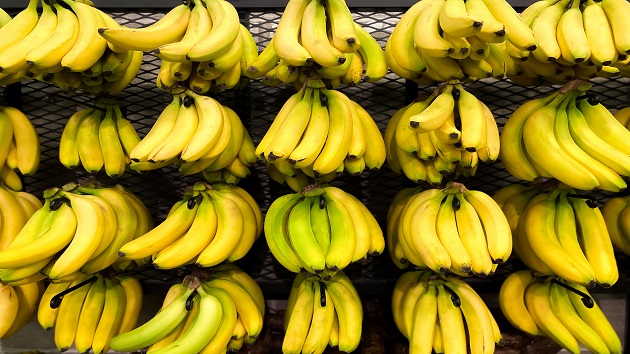(NEW YORK) — An apple a day may keep the doctor away, but a banana a day is cheaper.
While inflation has pushed prices up in most aisles of the grocery store, the common yellow fruit has impressively defied produce inflation and remained accessible to consumers across the country.
The average price of bananas, per pound, is 62 cents, while neighboring produce section fruits’ price tags are significantly higher, according to the Bureau of Labor Statistics, which reports the average price of apples ($1.32), lemons ($2.08), grapefruit ($1.71) and oranges ($1.55).
“Bananas are a fascinating example of everyday items that most people in the United States take for granted,” John Soluri, a history professor at Carnegie Mellon University and the author of “Banana Cultures: Agriculture, Consumption, and Environmental Change in Honduras and the United States,” told ABC News.
“We don’t think too much about bananas, because they are so ubiquitous, not only in grocery stores, but even in popular culture as well,” Soluri said, adding that bananas are considered “the poor man’s luxury.”
Bananas have been a staple fruit in the American diet for decades, with the U.S. importing more bananas by volume than any other country since 1961, according to the USDA.
The average American consumes nearly 27 pounds of bananas each year, which equates to about 90 bananas, and around the world, more than 100 billion bananas are eaten annually, according to Mayo Clinic.
Bananas were first introduced to the U.S. market during the World’s Fair in Philadelphia in 1876 as an “exotic” tropical fruit.
With increased market value for bananas, the United Fruit Company acquired huge amounts of land for plantations in Central and South America, according to Britannica, which notes, the term “Banana Republic” originated during this era.
“They started to acquire land, they built railroads, and they created a vertically integrated economy and commodity chain,” Soluri said. “They were growing and shipping bananas wholesale to the U.S.”
The United Fruit Company became part of the United Brands Company, in 1970, which was renamed Chiquita Brands International in 1990, according to Britannica, which remains one the world’s largest banana brands.
Most of the bananas the U.S. imports are grown in Guatemala, which accounts for approximately 41% of America’s supply, according to the USDA, which notes, Guatemala is the third largest banana exporting country globally, trailing Costa Rica and Columbia.
Bananas are perennial plants, meaning they live for more than one growing season without needing to be replanted. They also are a high-yield herb, offering up to 240 bananas per plant, according to the Rainforest Alliance.
The abundance of bananas grown in regions with low labor costs intersects with the fruit’s short shelf life and makes for a product that producers and grocery stores alike want to sell quickly.
There are hundreds of different varieties of bananas grown around the world, however, America mostly imports one variety — Cavendish bananas, according to Soluri, who suggests the monoculture of bananas in America makes the import system a well-oiled machine.
“Bananas arrive to grocery stores reliably, every week, and are priced relatively the same, with the quality being more or less the same,” Soluri said. “This only happens because a lot of people are working quite hard to make that possible — and, frankly, leading a lifestyle that would probably not satisfy a lot of the consumers in the United States.”
Copyright © 2024, ABC Audio. All rights reserved.












